Hyundai Palisade Dashboard Warning Lights
The Palisade has been manufactured by Hyundai since 2018 and is a popular mid-sized SUV. If you have a warning light illuminated on your Palisade’s dashboard, read below to find out what it means.
Each of the Hyundai Palisade dashboard warning lights are explained along with the recommended action to take. Dashboard display designs and warning light locations will vary depending on your specific version of Palisade.
Red warning lights require immediate attention as they can be a safety risk. Amber / yellow lights either indicate a minor fault, a maintenance issue or a system that has been switched off when by default it is on.
 Airbag Warning Light
Airbag Warning Light
The Hyundai Palisade airbag warning light illuminates for around 6 seconds when the ignition switch or button is set to ‘on’. The light turns off when all airbag and Safety Restraint System (SRS) have been completed.
If the system has determined a fault, the airbag warning light will remain lit. Ensure the system has not been manually disabled. Common causes for the airbag fault light include crash sensor issues, SRS module, seat occupancy sensors, airbag clock spring or a cable has been dislodged under the front seats.
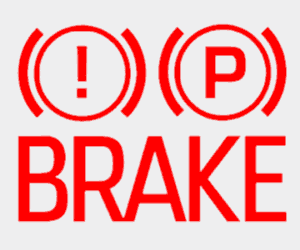 Brake Warning Light
Brake Warning Light
The Hyundai Palisade brake warning light serves two purposes; it informs you that the parking brake is on or that the brake fluid level is low. If the parking brake is properly set to off, it indicates the the fluid in the brake reservoir is low.
Drive your Palisade to a safe location and switch off the engine. Open the hood and check the brake fluid reservoir. The fluid level should be between MAX and MIN marks on the side of the reservoir. Use classification fluid: FMVSS116 DOT-4.
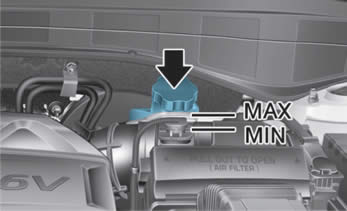
If the warning light remains on even after topping up with brake fluid, or the brakes do not operate properly, do not continue driving and contact a Hyundai workshop.
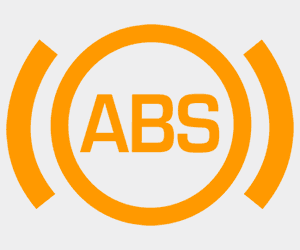 ABS Warning Light
ABS Warning Light
The Hyundai Palisade ABS warning light illuminates for around 3 seconds when the ignition switch or button is set to ‘on’. If the ABS (Anti-lock Braking System) warning light remains lit or comes on while driving, it means there’s a fault with the system. In this situation your normal hydraulic braking system will still be operational even if there is a malfunction with the
ABS.
Electronic Brake Force Distribution
If the ABS ![]() and brake
and brake ![]() warning light both come on together, it indicates a fault with the Electronic Brake Force Distribution (EBD) system. EBD distributes varying brake forces to individual wheels to allow for efficient braking. In this instance, ABS and your regular braking system may not function properly.
warning light both come on together, it indicates a fault with the Electronic Brake Force Distribution (EBD) system. EBD distributes varying brake forces to individual wheels to allow for efficient braking. In this instance, ABS and your regular braking system may not function properly.
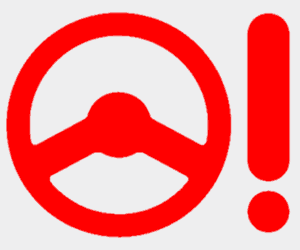 Power Steering Warning Light
Power Steering Warning Light
The Hyundai Palisade power steering warning light illuminates for around 3 seconds when the ignition switch or button is set to ‘on’, then switches off if no problems are detected.
If the power steering light remains lit, it may indicate a failure or temporary fault due to overheating. Occasionally the electric power steering can overheat if the steering is left on full-lock for extended periods when the engine is running, or if the driver is making constant left-to-right, lock-to-lock turning. In this instance, the warning light will switch off once the components have cooled.
 Smart Mode
Smart Mode
The Hyundai Palisade smart mode automatically selects the appropriate driving mode from Eco, Comfort, and Sport by judging the driver’s driving habits. The system determines either economical or aggressive style of driving based on brake pedal depression and steering wheel operation.
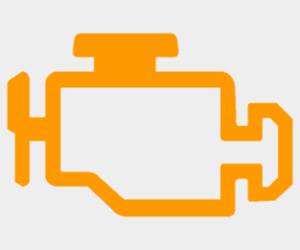 Engine Warning Light
Engine Warning Light
The Hyundai Palisade engine warning light illuminates for around 3 seconds when the ignition switch or button is set to ‘on’, then switches off if no problems are detected.
Whenever there is a malfunction with either the emission control system, the engine or the vehicle powertrain the engine warning light will illuminate. Due to the vast amount of issues that can trigger the engine warning light, it means there’s no specific action to take if the engine light comes on.
If the engine light remains on, connect diagnostic equipment which will enable you to read fault codes stored by the ECU. The fault codes allow you to find where the issue is.
You can usually continue driving with the engine warning light on, but the longer you go without repair, the worse the fault becomes. You may experience reduced engine power as part of the ECU’s safety override system to help protect against damage.
If the engine warning light begins flashing, reduce both vehicle and engine speed. If it continues flashing, seek repair from a Hyundai workshop right away to avoid catalytic converter damage. Some of the more common reasons for the engine warning light to come on include:
- Oxygen sensor
The oxygen sensor (O2 sensor) measures the amount of unburnt oxygen in a car’s exhaust system. - Catalytic converter
The catalytic converter is part of the vehicle’s emissions control system and converts carbon monoxide into carbon dioxide. - Spark plug/ignition coil
The ignition coil generates the electricity the spark plugs need to ignite the fuel in the engine. - Mass airflow sensor
The mass airflow (MAF) sensor monitors how much air enters the engine. - Exhaust gas recirculation valve
The exhaust gas recirculation (EGR) system reduces the amount of nitrogen oxide that that the engine emits and helps the engine to run more efficiently. - Loose gas cap
Sometimes the gas cap isn’t secured properly or becomes worn with age.
For further information, see reasons why the engine warning light is on.
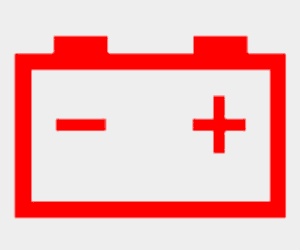 Battery Warning Light
Battery Warning Light
The Hyundai Palisade battery warning light should go off shortly after the engine has started. If it remains lit or comes on while driving, the battery is not being charged. When the battery power is exhausted, the engine will likely shut down.
If driving, immediately switch off any non-essential vehicle systems that consume electricity, such as heating, demisting, cooling system etc. Make your way immediately to the nearest vehicle repair workshop.
The usual cause for the battery warning light is alternator, drive belts loose or missing, voltage regulator, battery terminals or ageing battery. Vehicle batteries tend to show their age in colder weather.
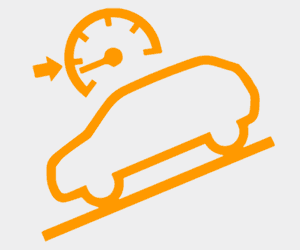 DBC Warning Light
DBC Warning Light
This Hyundai Palisade Downhill Brake Control (DBC) system is activated by pressing the DBC button and helps to reduce vehicle speed by automatically applying the brake while descending a hill. If the DBC warning light illuminates in yellow, it’s an indicator of a malfunction. A malfunction in the DBC may relate to a wheel speed sensor.
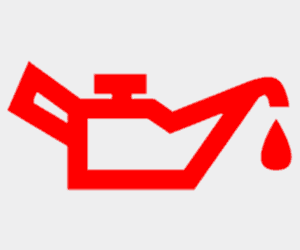 Oil Warning Light
Oil Warning Light
This Hyundai Palisade oil warning light is an indicator of low oil pressure and not low oil levels. However, very low oil levels can cause the low oil pressure warning light to come on. If it comes on, immediately pull off the road and switch off the engine.
Check oil levels and add oil if required. Only continue to drive if the oil light goes off. If the oil light remains lit or you do not have any oil available, call a Hyundai workshop or organize recovery. Some of the common reasons for the low oil pressure light coming on include:
- Low engine oil level
- Faulty oil pressure sensor
- Faulty oil pump
- Clogged oil pickup tube
- Clogged oil filter
- Internal oil leak
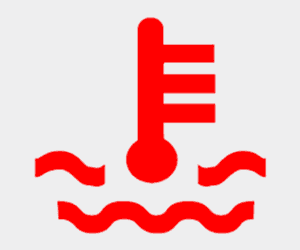 Engine Coolant Warning Light
Engine Coolant Warning Light
Engine coolant circulates throughout the engine helping to keep the engine from overheating. The Hyundai Palisade coolant warning light comes on as an indicator that the engine has overheated. Or the temperature gauge is displaying as ‘hot’.
If the coolant temperature warning light comes on or temperature gauge displays at hot while driving, pull off the road and switch off the engine. Allow several minute for the engine to cool, open the hood and check coolant levels.
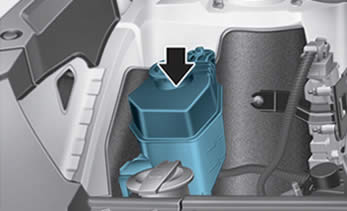
If coolant levels are low, use only distilled (deionized) water and add to the reservoir. The coolant level should be filled between the F and the L marks on the side of the coolant reservoir tank. If frequent additions are required, it may be an indicator of a leak. Check the condition and connections of all cooling system hoses and heater hoses. Replace any swollen or deteriorated hoses.
 Master Warning Light
Master Warning Light
The triangle containing an exclamation point is the Hyundai Palisade master warning light. It illuminates in yellow when a non-critical malfunction has occurred along with a message on the dashboard display panel. The possible malfunction associated with the mater warning light include:
- Malfunction with a LED headlight
- Malfunction with the Forward Collision-Avoidance Assist system
- The Forward Collision-Avoidance Assist radar is blocked (clean areas around radar sensor)
- Malfunction with the Blind-Spot Collision Warning system
- The Blind-Spot Collision Warning radar blocked (clean areas around radar sensor)
- Malfunction with the Smart Cruise Control with Stop & Go
- The Smart Cruise Control with Stop & Go radar blocked (clean areas around radar sensor)
- Headlight malfunction
- High Beam Assist malfunction
- Tire Pressure Monitoring System (TPMS) malfunction
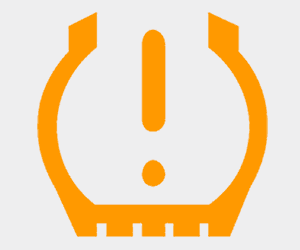 Tire Pressure Warning Light
Tire Pressure Warning Light
After around 3 seconds of the ignition being set to ‘on’, the Hyundai Palisade tire pressure warning light should go off. If it remains lit, or comes on while driving, it’s an indicator that one or more of your tires are significantly deflated. If the tire pressure light flashes for around 60 seconds, then remains lit, it’s an indicator of a Tire Pressure Monitoring System (TPMS) malfunction. Varies situations may affect the TPMS such as:
- Defective pressure sensors often damaged when tires are changed
- Your vehicle is close to a transmitter that interferes with the TPMS signal
- Electronic device interference
- Using snow chains
- Uneven tire wear
- Tires fitted that are not in accordance with the manufacturer’s guidelines
 FCA Warning Light
FCA Warning Light
The Hyundai Palisade Forward Collision-Avoidance Assist (FCA) system helps to avoid a frontal collision with other vehicles or pedestrians by use of radar and camera. FCA first warns the driver that a collision is imminent and if necessary, applies emergency braking.
If the FCA system is not working, ensure that the radar sensor located under the front grille and the camera sensor located at the top-center of the windshield are clear of mud, snow etc.
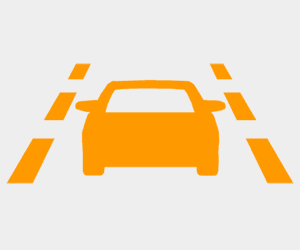 LKA Warning Light
LKA Warning Light
The Hyundai Palisade Lane Keeping Assist (LKA) alerts the driver via visual warning lights and audible alerts when the system detects an unintentional lane change. As with FCA, LKA uses the front camera located at the top-center of the windshield to detect lane lines. The LKA warning lights illuminate in the following colors:
- Green: When the system operating conditions are satisfied.
- White: The system operating conditions are not satisfied.
- Yellow: When there is a malfunction with the lane keeping assist system.
 AWD Warning Light
AWD Warning Light
The Hyundai Palisade All Wheel Drive (AWD) system delivers engine torque to both the front and rear wheels for extra traction. AWD is useful when maximum traction is required on slippery, muddy, wet, or snow-covered roads.
As with many of the Hyundai Palisade warning lights, the AWD warning light should go off after around 3 seconds of the ignition being set to ‘on’. If the light remains lit, it’s an indicator of a malfunction with the AWD system.
The AWD lock mode is to transfer a portion of the drive torque to the rear wheels for increased traction on wet pavement, snow covered roads or when driving off road. You can activate AWD lock mode by pressing the corresponding button. When activated, the AWS lock symbol ![]() illuminates on the dashboard.
illuminates on the dashboard.
 Headlight Warning Light
Headlight Warning Light
The headlight warning light illuminates when there’s a fault with the Hyundai Palisade’s LED headlights. The warning light flashes when there’s a fault with the LED headlight related part. Continued driving with the LED headlight warning light on may reduce the lifespan of the headlight.
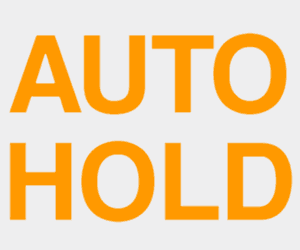 Auto Hold Warning Light
Auto Hold Warning Light
The Auto Hold system keeps the vehicle at a standstill even though the brake pedal is not depressed after the driver brings the vehicle to a complete stop by depressing the brake pedal. The auto hold warning light illuminates in the following colors:
- White: When the auto hold system is activated via the auto hold button.
- Green: By depressing the brake pedal, the vehicle comes to a complete stop with the auto hold system activated.
- Yellow: When there is a malfunction with the auto hold system.
 Ice Warning Light
Ice Warning Light
The Hyundai Palisade snowflake symbol is an icy road warning. The symbol illuminates to warn the driver that the roads may be icy and to drive attentively. When the outside temperature is below 40°F (4°C), the icy road warning light flashes, then remains lit along with an audible warning alert. The icy road warning system can be deactivated in the user settings mode.
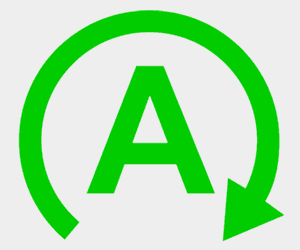 Auto Stop Start Warning Light
Auto Stop Start Warning Light
The Hyundai Palisade auto stop start warning light illuminates when the ISG (Idle Stop and Go) system enters the engine on standby. When auto start occurs, the auto stop warning light flashes for 5 seconds.
Hyundai Palisade Auto Stop Start Not Working
If the automatic engine stop start system is not working on your Hyundai Palisade, it’s likely that one or more of the following conditions has not been met for the ISG system to inhibit the engine.
- The driver has their seatbelt fastened
- The driver’s door is closed
- The hood is closed
- The brake vacuum pressure is adequate
- The battery sensor is activated
- The battery is sufficiently charged (most common problem)
- The Outside temperature is not too low or too high
- The vehicle is driven over a constant speed and stops
- The climate control system satisfies the conditions
- The vehicle is sufficiently warmed up
- The road incline is is not too steep
- The steering wheel is turned less than 180 degrees and then the vehicle stops
Auto Stop Start and Other Warning Lights
Other warning lights such as the ABS, ESC, ESC OFF, EPS or parking brake warning light may illuminate when the engine is automatically started by the ISG system. This happens because of low battery voltage and does not indicate that the system has malfunctioned.
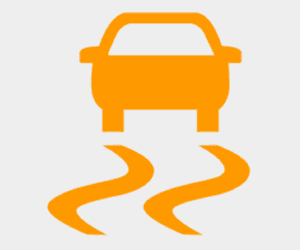 ESC Warning Light
ESC Warning Light
The Hyundai Palisade ESC (Electronic Stability Control) system is a vehicle safety feature that helps to reduce understeer, oversteer and improve traction with the road surface. ESC is on by default, but can be manually switched off if required. See what is ESC in cars and how does ESC work for further information.
The ESC light flashes as an indicator that the system is actively operating, but if it remains constantly lit, it’s an indicator of a fault. The most common cause of ESC fault is due to a bad wheel speed sensor, or steering angle sensor.
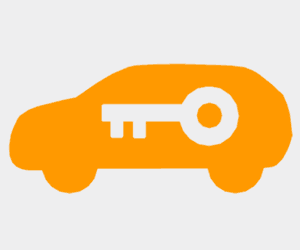 Immobilizer Warning Light
Immobilizer Warning Light
The car and key symbol is the Hyundai Palisade immobilizer warning light. The immobilizer light should come on when the vehicle detects the transponder in the key and the engine can be started.
If the immobilizer light flashes, it’s an indicator of a fault. Try a different key if you have one. Disconnecting the battery for a period of time can also help to reset the system. If you have a capable scan code reader, this may help to read fault codes.
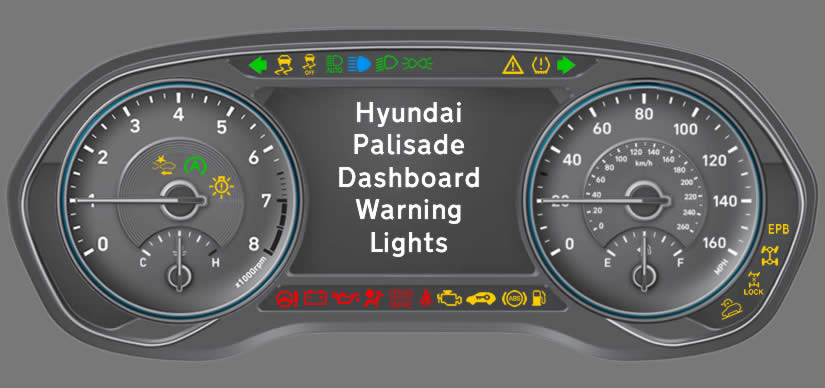
What does the HD Traffic warning light mean on my hyundai palasaide?